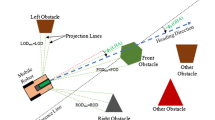Abstract
This paper presents a hybrid path planning algorithm for the design of autonomous vehicles such as mobile robots. The hybrid planner is based on Potential Field method and Voronoi Diagram approach and is represented with the ability of concurrent navigation and map building. The system controller (Look-ahead Control) with the Potential Field method guarantees the robot generate a smooth and safe path to an expected position. The Voronoi Diagram approach is adopted for the purpose of helping the mobile robot to avoid being trapped by concave environment while exploring a route to a target. This approach allows the mobile robot to accomplish an autonomous navigation task with only an essential exploration between a start and goal position. Based on the existing topological map the mobile robot is able to construct sub-goals between predefined start and goal, and follows a smooth and safe trajectory in a flexible manner when stationary and moving obstacles co-exist.
Similar content being viewed by others
Explore related subjects
Discover the latest articles and news from researchers in related subjects, suggested using machine learning.References
Khatib O (1986) Real-time obstacle avoidance for manipulators and mobile robots. Int J Robot Res 5(1): 90–98
Volpe R, Khosla P (1990) Manipulator control with superquadric artificial potential functions: theory and experiments. IEEE Trans Syst Man Cybernet
Zwynsvoorde DV, Simeon T, Alami R (2000) Incremental topological modeling using local Voronoi-like graphs. In: Proc of IEEE Int Conf on Intelligent Robots and System
Latombe JC (1991) Robot motion planning. Kluwer Academic Publishers, Boston, MA
Borenstein J, Koren Y (1991) The vector field histogram—fast obstacle avoidance for mobile robots. IEEE Trans Robot Autom 7(3): 278–288
Kavraki LE, Svestka P, Latombe JC, Overmars M (1996) Probabilistic roadmaps for path planning in high dimensional configuration spaces. IEEE Trans Robot Autom 12(4): 566–580
Krogh BH (1984) A generalized potential field approach to obstacle avoidance control. In: Proc of SME Conf on Robotics Research
Lau H (2003) Behavioural approach for multi-Robot exploration. In: Proc of Australasian Conf on Robotics and Automation
Connolly CI (1992) Applications of harmonic functions to robotics. In: Proc of IEEE Int Sympo on Intelligent Control, pp 498–502
Connolly CI, Grupen RA (1993) On the application of harmonic functions to robotics. J Robot Syst 10(7): 931–946
Koditschek DE, Rimon E (1990) Robot navigation functions on manifolds with boundary. Adv Appl Math 11: 412–442
Borenstein J, Koren Y (1989) Real-time obstacle avoidance for fast mobile robots. IEEE Trans Syst Man Cybernet 19: 1179–1187
Chang Ya-Chun, Yamamoto Y (2006) Dynamic decision making of mobile Robot under obstructed environment. In: Proc of IEEE/RSJ Int Conf on Intelligent Robots and Systems
Hough PVC (1962) Method and means for recognizing complex patterns. US Patent 3,069,654
Yamamoto Y, Yun X (1997) A modular approach to dynamic modeling of a class of mobile manipulators. Int J Robot Autom 12(2): 41–48
Thrun S (1998) Learning metric-topological maps for indoor mobile robot navigation. Artif Intell 99(1): 21–71
Mahkovic R, Slivnik T (2000) Constructing the generalized local voronoi diagram from laser range scanner data. IEEE Trans Syst Man Cybernet 30(6): 710–719
Choset H, Nagatani K (2001) Topological simultaneous localization and mapping (SLAM): toward exact localization without explicit localization. IEEE Trans Robot Autom 17(2): 125–137
Barraquand J, Langlois B, Latombe JC (1992) Numerical potential field techniques for robot path planning. IEEE Trans Syst Man Cybernet 22(2): 224–241
Author information
Authors and Affiliations
Corresponding author
Rights and permissions
About this article
Cite this article
Chang, YC., Yamamoto, Y. Path planning of wheeled mobile robot with simultaneous free space locating capability. Intel Serv Robotics 2, 9–22 (2009). https://doi.org/10.1007/s11370-008-0033-4
Received:
Accepted:
Published:
Issue Date:
DOI: https://doi.org/10.1007/s11370-008-0033-4




